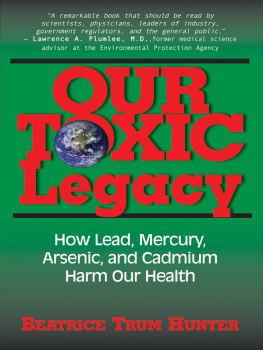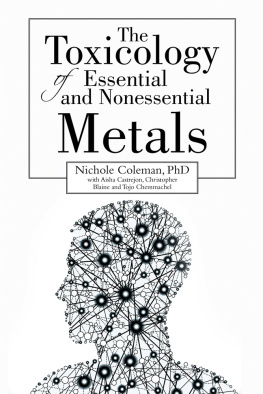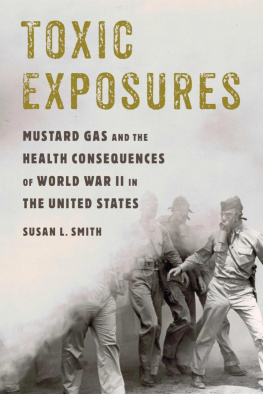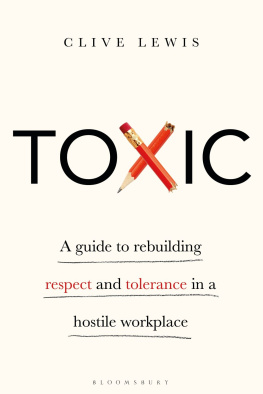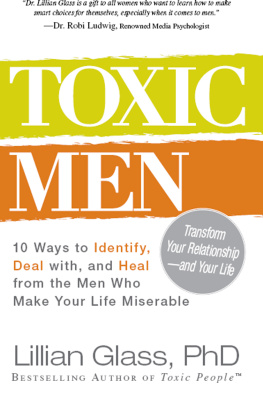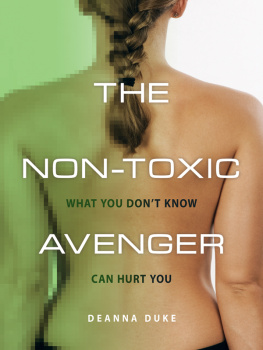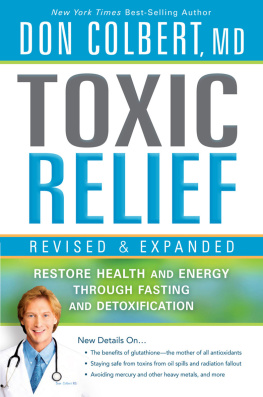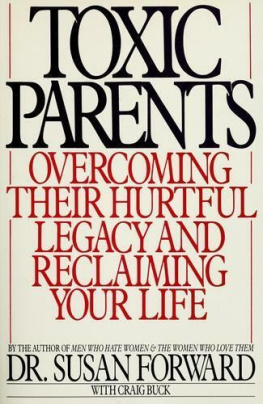Beatrice Trum Hunter - Our Toxic Legacy
Here you can read online Beatrice Trum Hunter - Our Toxic Legacy full text of the book (entire story) in english for free. Download pdf and epub, get meaning, cover and reviews about this ebook. year: 2011, publisher: Basic Health Publications, genre: Romance novel. Description of the work, (preface) as well as reviews are available. Best literature library LitArk.com created for fans of good reading and offers a wide selection of genres:
Romance novel
Science fiction
Adventure
Detective
Science
History
Home and family
Prose
Art
Politics
Computer
Non-fiction
Religion
Business
Children
Humor
Choose a favorite category and find really read worthwhile books. Enjoy immersion in the world of imagination, feel the emotions of the characters or learn something new for yourself, make an fascinating discovery.
- Book:Our Toxic Legacy
- Author:
- Publisher:Basic Health Publications
- Genre:
- Year:2011
- Rating:4 / 5
- Favourites:Add to favourites
- Your mark:
- 80
- 1
- 2
- 3
- 4
- 5
Our Toxic Legacy: summary, description and annotation
We offer to read an annotation, description, summary or preface (depends on what the author of the book "Our Toxic Legacy" wrote himself). If you haven't found the necessary information about the book — write in the comments, we will try to find it.
Our Toxic Legacy describes the unique characteristics of each of these four major toxic metals and identifies the likely sources of our exposures.
Our Toxic Legacy — read online for free the complete book (whole text) full work
Below is the text of the book, divided by pages. System saving the place of the last page read, allows you to conveniently read the book "Our Toxic Legacy" online for free, without having to search again every time where you left off. Put a bookmark, and you can go to the page where you finished reading at any time.
Font size:
Interval:
Bookmark:
The information contained in this book is based upon the research and personal and professional experiences of the author. It is not intended as a substitute for consulting with your physician or other healthcare provider. Any attempt to diagnose and treat an illness should be done under the direction of a healthcare professional.
The publisher does not advocate the use of any particular healthcare protocol but believes the information in this book should be available to the public. The publisher and author are not responsible for any adverse effects or consequences resulting from the use of the suggestions, preparations, or procedures discussed in this book. Should the reader have any questions concerning the appropriateness of any procedures or preparation mentioned, the author and the publisher strongly suggest consulting a professional healthcare advisor.
Basic Health Publications, Inc.
28812 Top of the World Drive
Laguna Beach, CA 92651
949-715-7327 www.basichealthpub.com
Library of Congress Cataloging-in-Publication Data
Hunter, Beatrice Trum.
Our toxic legacy : how lead, mercury, arsenic, and cadmium harm our health /
Beatrice Trum Hunter.
p. cm.
Includes bibliographical references and index.
ISBN 978-1-59120-284-4
1. Heavy metalsToxicology. 2. Heavy metals--Environmental aspects.
I. Title.
RA1231.M52H88 2011
615.9'253_c23
2011023633
Copyright 2011 Beatrice Trum Hunter
All rights reserved. No part of this book may be reproduced, stored in a retrieval system, or transmitted by any means, electronic, mechanical, photocopying, recording, or otherwise, without written permission from the author.
Editor: Cheryl Hirsch
Typesetting/Book design: Gary A. Rosenberg
Cover design: Mike Stromberg
Printed in the United States of America
10 9 8 7 6 5 4 3 2 1
Dedicated to
Paul D. Granoff, M.D.
Dan M. Granoff, M.D.
and
Gary C. Granoff, Esq.
with appreciation, admiration, and affection
Lead, mercury, arsenic, and cadmium are major toxic metals. All are environmental pollutants that can inflict harm on humans and other living creatures as well as adversely affect our air, water, soil, and food supply. Two of them_lead and mercury_are neurotoxins. They can poison not only us but also our progeny developing in the womb. The other two_arsenic and cadmium_have some carcinogenic forms. All four metals can break down the bodys basic functions.
This book demonstrates the failure of federal regulatory agencies to be proactive rather than reactive. The pattern has been to act too little and too late. Regulations have been lax, delayed, or not enforced. The regulations, themselves, have been formulated to accommodate economic interests rather than to protect public health based on sound science.
There have been a few success stories, notably with lead. Today, most gasoline is unleaded, house paint is no longer manufactured with lead, and food cans are lead free due to banning of the use of lead solder for this purpose. However, these victories are small, compared with what needs to be done.
Herbert L. Needleman, a pediatrician, child psychiatrist, researcher, and professor at the University of Pittsburgh Medical Center with whom the reader will become acquainted, remarked about lead toxicity that unlike genetic, infectious, or metabolic disease, it is not a biologic mystery It is a completely preventable disease; the mystery resides in its continued existence. The same can be said of mercury, arsenic, and cadmium toxicity.
Beatrice Trum Hunter
July 2011
CHAPTER 1 | |
| LEAD: The Cause of a Vast and Silent Epidemic |
L ead (Pb) is present in the earths crust. Through the millennia, it remained there, locked in ore. Lead was the first metal to be extracted from its ore, because where lead is deposited, so too is silver. The early mining of lead introduced humans to metal technology.
Lead is not a required nutrient. Nor is there any known biological function for lead. There may be no threshold concentration for its toxicity. Derek Bryce-Smith, professor of chemistry at the University of Reading, England, appraised the metal succinctly, the only good lead is no lead. Scientifically, the only appropriate absorption level of lead is zero.
Despite the harmful health aspects of lead, it is an attractive metal. It is malleable and durable, with thousands of uses. In addition, by extracting lead from ore, silver is released as well.
Lead was prized in the ancient world. The Greek mines at Laurium were in operation well before 3000 B.C. The British Museum has a lead statue found in Turkey that dates back to about 6000 B.C. The wealth of the Persian kings is attributed to their abundance of lead/silver deposits. The Persians introduced silver coinage in about 750 B.C. This development was a major stimulus for further mining. By Roman times, nearly all the major lead/silver deposits in the Mediterranean and western European areas had been discovered, and extraction from these mines continued throughout the centuries. The Romans used lead mined in Britain for pipes to supply water to public baths.
Silver taken from lead ore became the chief unit of exchange in the Middle East. A technique to extract the silver from lead ore was called cupellation. The metallic mixture was oxidized at high temperatures, and the base metal (lead) separated from the noble metal (silver) by absorption into the walls of a cupel cup. The technique spread to other parts of the ancient world, and remained as a dominant process to recover silver for nearly 5,000 years.
Old bones, old Roman recipes, and remnants of old lead-lined pots provide some clues of the numerous environmental exposures to lead, especially of the upper classes, during the Roman Empire (27 B.C.-393 A.D.). Some historians attribute lead poisoning as a major factor in the Roman Empires decline.
Lead was used for water pipes, roofing, containers, cups, statuettes, tokens, coins, lids, sieves, household repair aids, solder, paint, cosmetics, external medications, boxes, markers, writing tablets, and coffins, as well as in many alloys with copper (lead bronze) and with tin (pewter).
The most significant uses of lead were in the kitchens of the upper classes, and in their foods and beverages. Lead was present in wine and other drinks made from fruit or honey, olive oil, grape syrup, and preserved fruits. Lead was in the amphoras, containers used to store these items, as well as in the cooking pots. The heat in cooking greatly increased the absorption of lead, especially if the pots were scraped from time to time to prevent burning of thick liquids such as grape syrup, used to sweeten and preserve foods and beverages.
Wine was a major delivery system for lead. The Romans boiled unfermented grape juice (called must) into a concentrate, using solid lead pots. The resulting sweet syrup was added to wine to give it bouquet and strength. By killing any microorganisms present in the grape juice that would cause the wine to spoil, the syrup prolonged the wines shelflife. The grape syrup was used, too, to preserve olives, plums, cherries, apples, pears, peaches, and quinces. The grape syrup also was an ingredient in many luxury dishes, as reflected in a cookbook written by the epicure, Marcus Gavius Apicius.
Minor amounts of lead in wine came from the leaded storage and drinking vessels, from the lead-contaminated water mixed with wine, from the grape syrup used to cement the amphoras stopper, from the leaden clamps used inside and outside of a mended cracked amphora, and perhaps even from the leaded parts in the winepress. Grapes and wine, being acidic, readily leached lead.
Next pageFont size:
Interval:
Bookmark:
Similar books «Our Toxic Legacy»
Look at similar books to Our Toxic Legacy. We have selected literature similar in name and meaning in the hope of providing readers with more options to find new, interesting, not yet read works.
Discussion, reviews of the book Our Toxic Legacy and just readers' own opinions. Leave your comments, write what you think about the work, its meaning or the main characters. Specify what exactly you liked and what you didn't like, and why you think so.

